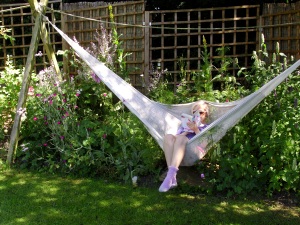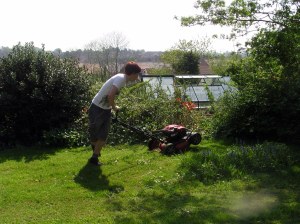Originally this garden was overshadowed by 2 huge conifers on the south side – these were removed around the turn of the century, allowing the light in. We call this ‘the naked garden’ because it’s almost un-overlooked, and it would be possible to garden naked here. Also for the statue by the pond.
The pond was renovated in 2012. It has a few goldfish and is a haven for newts and frogs. It seems to be made from a buried water tank and may be fed from the run off from the house roof. The seat by the pond is a great suntrap in autumn and spring.
The brick work around the steps needs renovating and has been on the ‘to-do’ list for several years. The garden is separated from the drive by an ‘indian rope trick’. We had the rope and wanted to use it to make the fencing. I said it would be good if it could magically be used to form an arch, and Keith devised the ‘rope trick’. The sides of the arch are formed from upcycled concrete re-enforcing left in the garden by the previous owner. Over the arch is Etoile de Hollande climbing rose.
The flower beds in this garden need further planting and rationalising, we feel. However, the hammock area is a particular pleasure on a warm summer afternoon. The planting has been designed to be romantic and flowery. However, this bed is very dry and new, more suitable, planting is being devised, along with some mulching (probably gravel) and an irrigation system.
The hedge along the south side of the garden is an evergreen wildlife hedge, and has proved very popular with the local birds who quickly devour the berries it provides, as winter progresses. Many of the berries are also edible for humans too, although not commonly consumed. The hedge contains Berberis darwinii, Cotoneaster franchetii, Pyracantha Orange Glow, Escallonia Donard Seedling, Photinia fraseri Red Robin, Viburnum tinus and pre-existing holly and laurel bushes.
We are not great believers in fine lawns. This lawn has lots of clover and self-heal in it, which some might regard as weeds. However, they are drought-tolerant plants and the lawn remains green, even in the driest years. The design here is not the most organically friendly – the brick work quickly becomes overgrown and disappears, if weeding is not done meticulously. In 2012, I decided to adopt a pragmatic approach to organic gardening and use weedkillers in limited areas (like these bricks) where necessary. Obviously it would be possible to maintain these organically if we were retired, but in the meantime, a pathclear type product is used each April. The alternative is to remove the bricks and re-level the lawn – a massive and expensive project with a corresponding carbon footprint. Here, weedkillers may well be the lesser of two evils. Leaving the bricks to get overgrown with grass and moss is an option, but an unattractive one, which has also led to twisted ankles!






